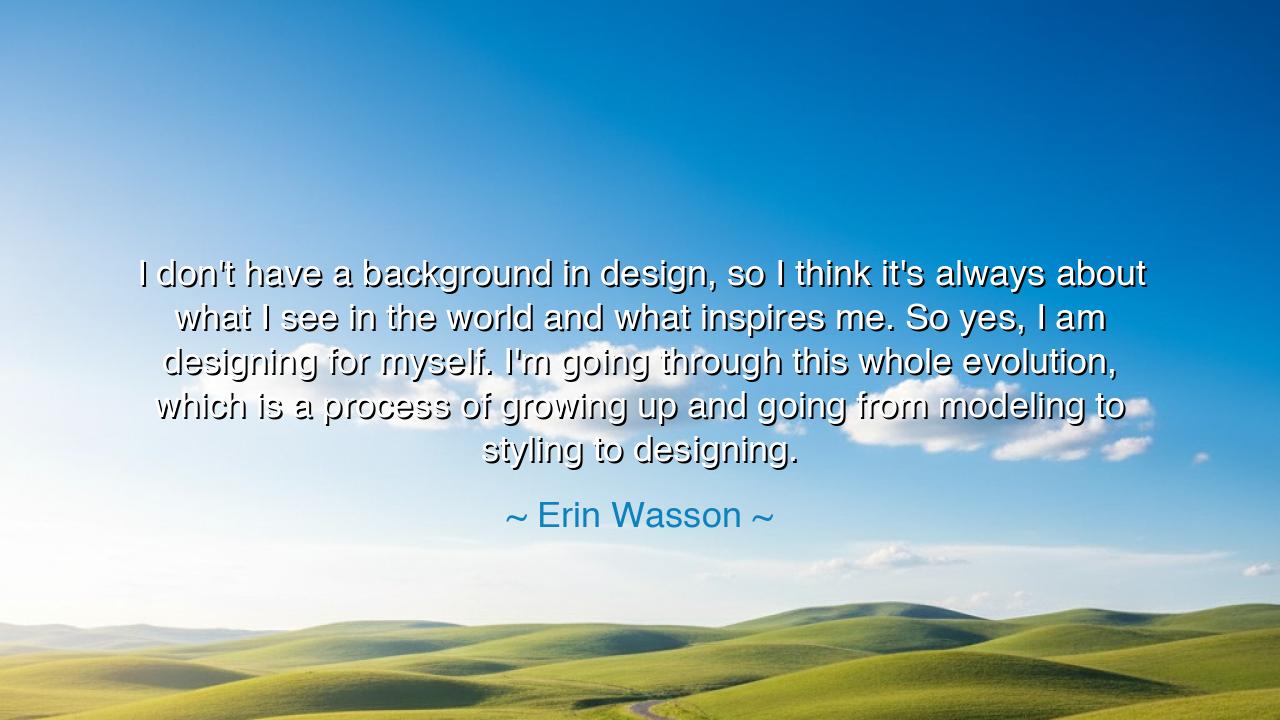
I don't have a background in design, so I think it's always about
I don't have a background in design, so I think it's always about what I see in the world and what inspires me. So yes, I am designing for myself. I'm going through this whole evolution, which is a process of growing up and going from modeling to styling to designing.






“I don’t have a background in design, so I think it’s always about what I see in the world and what inspires me. So yes, I am designing for myself. I’m going through this whole evolution, which is a process of growing up and going from modeling to styling to designing.” Thus spoke Erin Wasson, a woman who walked the runways of fashion only to discover that her truest creation would not be how she appeared before others, but what she could shape from within. Her words carry the quiet wisdom of transformation—the realization that life itself is a continual act of design, not of fabrics and forms alone, but of the self.
When Wasson says she has no “background in design,” she is not confessing a weakness but revealing a strength. For what is design, if not the art of perceiving the world and reshaping it through one’s own vision? True creation is not learned through formal training—it is born of attention, curiosity, and courage. She sees not with the eyes of an academic but with the eyes of a soul attuned to beauty and imperfection alike. This is the essence of all authentic art: to begin not from mastery, but from wonder.
Her statement, “I am designing for myself,” is both defiant and sacred. It is the declaration of a spirit no longer content to mirror the desires of others, but determined to express her own. Having spent years as a model—a vessel for other people’s visions—Wasson’s evolution into styling and design marks the rebirth of individuality. In her words, we hear the echo of the ancient artist stepping out of shadow, claiming the right to define her own form. She teaches us that to design for oneself is not selfish—it is an act of liberation. It is to say: I, too, am worthy of authorship.
This journey of transformation mirrors that of many great creators. Consider Michelangelo, who began his life as an apprentice under the discipline of others, shaping marble according to the will of his masters. But when at last he stood before the raw block that would become David, he no longer sculpted to please others—he sculpted to reveal truth. From submission, he rose to creation. So too does Wasson rise—from the body that others dressed to the mind that envisions, from the object of gaze to the architect of meaning. In her evolution, we witness the eternal law of the creative spirit: that every true artist must one day leave imitation behind to find her own voice.
Her description of “evolution” is the very heartbeat of the human story. To grow is to transform—to shed skins, to reimagine, to begin again. She does not present her evolution as a triumph of skill, but as a process of growing up, a phrase both tender and profound. It reminds us that maturity is not the loss of wonder, but its refinement. Each stage—modeling, styling, designing—is a chapter in her awakening, a deepening of her relationship with the world and with herself. Through this process, she embodies the wisdom of becoming: that every vocation, no matter how external, can be a path toward inner truth.
Her inspiration, she says, comes from “what I see in the world.” There lies the soul of her artistry—the ability to see not just with the eyes, but with the heart. For the world is full of teachers: the curve of a leaf, the texture of sand, the rhythm of a city street. To see is to listen, to allow the universe to speak through color, form, and feeling. Like the ancient philosophers who sought harmony in the cosmos, Wasson finds beauty in the ordinary, and through that vision, she creates. Her art becomes a reflection of life itself—imperfect, fluid, and profoundly human.
The lesson in her words is both humble and heroic: each of us is designing our life, whether we realize it or not. We may not all be artists, but we are all creators—of choices, of paths, of identities. One need not have a “background” in greatness to live meaningfully; one needs only the courage to observe, to evolve, and to act in authenticity. Like Wasson, we must dare to design for ourselves—to make of our days something that bears the signature of our own spirit, not the expectations of others.
And so, Erin Wasson’s reflection stands as a testament to the art of becoming. She reminds us that growth is not a straight line, but a spiral that returns us, wiser, to the center of who we are. We must look outward for inspiration, yes—but ultimately, we must create inwardly, in alignment with our truth. For to design for oneself is to live as both artist and artwork, crafting a life that is not merely worn, but embodied, not merely seen, but felt.






AAdministratorAdministrator
Welcome, honored guests. Please leave a comment, we will respond soon